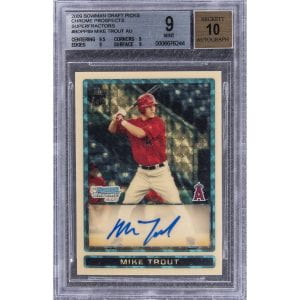Recent Surge in Sports Cards Value Results in Record Breaking Auction
All of us sports fans remember way back when we were kids, the feeling of ripping open a card pack potentially filled with our favorite players. Whether it be baseball, football, basketball, soccer, or any other sport, the feeling of revealing the player you idolize from a pack was invigorating and encapsulating. With Covid-19 decimating our country’s economy, many have scrambled to put their wealth into appreciating liquid assets such as gold and trading cards. Recently, a Mike Trout Rookie baseball card was up for auction and sold for a whopping 3.936 million dollars. The seller of the card, Dave Oancea, had originally purchased it for the astonishingly “low” price of $400,000. At the time he bought it, he stated “A lot of people had a lot of negative things to say, that I was crazy, you know” (Forbes). As you can imagine, this had sports fans, including myself, around the world dig up their old piles of cards just hoping they have any card worth a fraction of what this just sold for.
 Mike Trout’s 1/1 Autographed Rookie Card
Mike Trout’s 1/1 Autographed Rookie Card
Interestingly enough, we have talked a lot about auctions during our class, and I was intrigued to see what kind of auction this was and make any sort of connections to the material we learned. The auction took place on “goldinauctions.com”, a widely known and well respected auction site that specializes in sports memorabilia, on August 19th 2020. After doing some research on the site, I found out that this auction was essentially a First Price Auction. This means the card would be sold to the highest bidder at the end of the auction leading us to believe the bidders should and will bid BELOW their true value of the card instead of their actual true value. This is because if they were to win the auction, they will pay what they actually bid unlike a Second Price Auction where you pay the second highest bid. Another interesting part of this auction was that it had a set reserve price on the card meaning that if a bid did not exceed or at least match the reserve price, the card would not be sold. The reserve price was set at $1,000,000 but this auction had no issue exceeding that number. Another interesting aspect of this auction/auction site is their service of “up to” or “limit” bids. Essentially, a bidder may enter in the maximum amount he or she is willing to spend for the item and the software will take that number and competitively bid throughout the auction without the bidder actually having to do it. The software does it in 10% increments of whatever the “limit” bid was entered as and will bid all the way up to, but not passed, that bid. As we have learned and stated before, ideally a bidder using this function will not enter in their true value. With the recent boom in value for trading cards, it will be interesting to follow future auctions that take place and compare the way they operate with what we have learned about auctions and strategizing as bidders.
Sources:
https://goldinauctions.com/rules.aspx
https://www.cbssports.com/mlb/news/mike-trout-rookie-card-sells-for-record-3-93m-at-auction/
